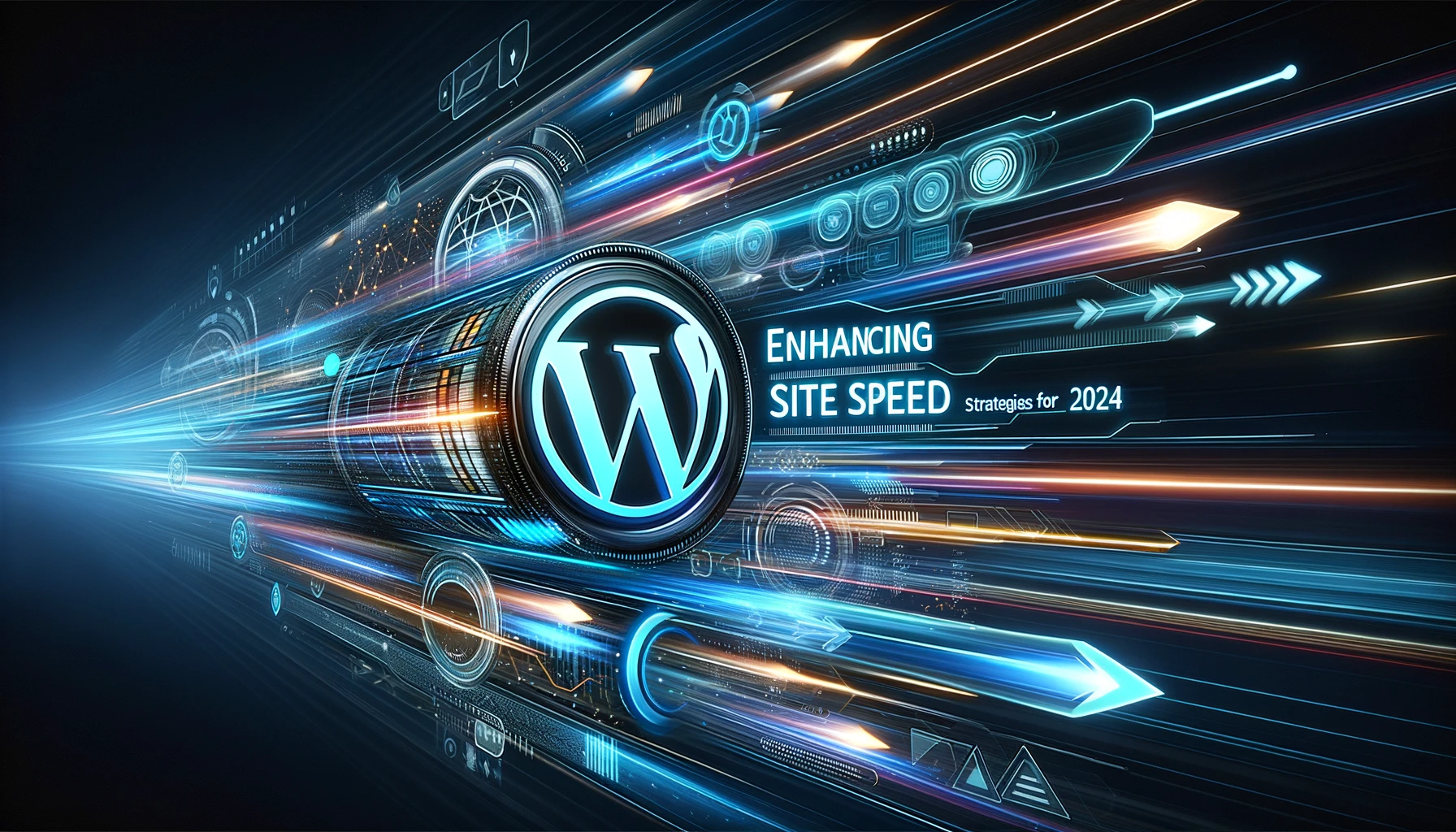In the digital landscape of 2024, the speed of your WordPress site is more than a convenience—it’s a critical factor in user engagement, SEO rankings, and overall digital success. This comprehensive guide delves into the multifaceted approach to WordPress speed optimization, offering a blend of technical insights and practical steps tailored for professionals seeking to enhance their online presence.
The Critical Need for Speed in WordPress
When we talk about WordPress sites, speed isn’t just a technicality; it’s the backbone of user experience and conversion. Let’s dive into why this is so crucial. Imagine a visitor lands on your site, and it takes ages to load. Chances are, they’ll leave before even seeing what you have to offer. This is where the speed of your site becomes pivotal. It’s not just about making a good first impression; it’s about holding onto that visitor long enough to engage them and, hopefully, convert them into a customer or subscriber. The faster your site, the better the user experience, which directly correlates to higher engagement and conversion rates.
Now, let’s shift gears to SEO, specifically Google’s Core Web Vitals. These are a set of factors that Google considers important in a webpage’s overall user experience. Core Web Vitals are part of these factors, and they play a significant role in your site’s search engine ranking. Essentially, Google uses these metrics to gauge the quality of experience your site provides. For instance, if your site takes too long to load, it’s seen as offering a poor user experience, which can negatively impact your ranking in search results. In essence, optimizing for Core Web Vitals isn’t just about appeasing search engines; it’s about providing a seamless, enjoyable experience for your visitors. And in the world of SEO, a happy visitor often translates to a higher ranking.
Foundational Aspects of WordPress Speed
When we delve into the realm of WordPress speed, the foundation is undoubtedly the hosting solution you choose. It’s a critical decision that goes beyond just price and brand name. The right hosting solution should align seamlessly with your site’s speed requirements. Think of it as choosing a home for your website; the better the foundation, the more stable and efficient your site will be.
Now, let’s talk about the different types of hosting environments because they’re not all created equal. First up, we have shared hosting, which is like living in an apartment complex. It’s affordable, but you share resources with other websites, which can affect your site’s performance, especially if one of your neighbors is hogging all the resources.
Then there’s dedicated hosting, akin to owning a standalone house. Here, you have all the resources to yourself, which is fantastic for speed and performance, but it comes with a higher price tag.
Lastly, we have cloud hosting. This is like having a network of houses where you can move around as needed. It’s flexible and scalable, meaning you can adjust resources based on your site’s traffic. Cloud hosting is particularly effective in handling traffic spikes without compromising on speed.
Each of these hosting environments has its own impact on your site’s performance, so understanding their differences is key to making an informed decision that benefits your WordPress site’s speed and overall performance.
Advanced Speed Optimization Techniques
Diving into the world of advanced speed optimization for WordPress, there are a few key strategies that can really make a difference. First off, let’s talk about caching. Implementing effective caching solutions is like giving your website a turbo boost. It stores a version of your site so that it doesn’t have to load from scratch every time someone visits. This significantly reduces load times, making for a much smoother and faster user experience. It’s like having a fast-food version of your site ready to go, without the wait.
Next up, we have Content Delivery Networks, or CDNs. These are absolute game-changers when it comes to speeding up your site, especially if your audience is spread across the globe. A CDN stores copies of your site in various locations around the world, so when someone accesses your site, they’re downloading it from a server that’s closest to them. This drastically cuts down on loading times, no matter where your visitors are located. It’s like having multiple express delivery trucks for your site’s content, each strategically placed to ensure the quickest delivery possible.
Lastly, let’s not forget about optimizing media and content. This involves compressing your images and videos without losing quality, so they take up less space and load faster. It’s a bit like packing for a trip with a small suitcase; you want to bring everything you need without it being too heavy or bulky. By optimizing your media, you ensure that your site remains visually appealing but doesn’t get bogged down by large file sizes. This way, your site not only looks great but also performs efficiently, providing a seamless experience for your users.
Streamlining WordPress for Peak Performance
In the quest for peak performance in WordPress, streamlining is key. Let’s start with theme and plugin optimization. It’s all about striking that perfect balance between speed and functionality. When selecting themes and plugins, think of them as the gears of a finely-tuned sports car. You want them to be sleek and efficient, adding to your site’s performance without weighing it down. It’s crucial to choose ones that are coded for speed, yet still deliver the functionality you need. Regularly reviewing and managing these themes and plugins ensures they continue to work in harmony, keeping your site running smoothly.
Moving on to database optimization, this is where you keep the engine of your WordPress site in top condition. Over time, databases can become cluttered with unnecessary data, slowing down your site. Regularly cleaning up your database, much like tuning a car’s engine, keeps it running efficiently. This might involve tasks like removing old revisions, cleaning up spam comments, or getting rid of unused data. A lean and efficient database means faster response times and a more responsive site.
Lastly, let’s talk about minimizing external scripts and HTTP requests. Every time your site loads, it calls on various external scripts and resources, which can significantly slow down loading times. It’s like having too many minor tasks that distract from the main goal. By reducing these external calls, you streamline the process, allowing your site to focus on loading the essential elements quickly and efficiently. This might involve combining scripts, reducing the use of external fonts and widgets, or optimizing loading sequences. The goal is to reduce the load on your site, making it faster and more efficient for your visitors.
Advanced Technical Enhancements
In the realm of WordPress, diving into advanced technical enhancements can significantly uplift your site’s performance. Let’s break down some of these sophisticated strategies.
Starting with advanced caching and database techniques, think of this as fine-tuning the engine of a high-performance race car. Sophisticated caching mechanisms work by storing frequently accessed data in a readily available state, drastically reducing load times. It’s like having a quick-access shelf for your most-used tools, saving you the time of digging through a toolbox every time. Similarly, efficient database management ensures that your site’s backend is running smoothly and swiftly, free from clutter and unnecessary data. This involves regular clean-ups and optimizations to ensure that your database is not a bottleneck but a facilitator of speed.
Now, let’s talk about integrating Google Fonts. While these fonts add aesthetic appeal to your site, they can also impact loading times if not used judiciously. The key is to use them effectively without burdening your site. This involves selecting only the font styles and weights you need, hosting them locally if possible, and ensuring they’re loaded in the most efficient manner. It’s like choosing the right accessories that enhance your outfit without overloading it.
Lastly, implementing lazy loading and pagination is another technique to boost site performance. Lazy loading is like a smart energy-saving mode; it loads images and content only when they’re needed – as a user scrolls down your site. This prevents unnecessary loading of off-screen content, making initial page loads much faster. Pagination, on the other hand, divides content into separate pages, reducing the weight of each page and allowing for quicker loading times. It’s akin to reading a book – you only open one page at a time, making it easier and quicker to handle.
By employing these advanced technical enhancements, you’re not just speeding up your site; you’re also crafting a more efficient and enjoyable user experience.
Maintaining and Monitoring Site Speed
In the world of WordPress, maintaining and monitoring site speed is akin to keeping a high-performance vehicle in top condition. It’s not just about the initial setup; ongoing care is crucial to ensure your site continues to run smoothly and efficiently.
Regular updates and maintenance form the cornerstone of this process. Just as you would regularly service a car to keep it running at its best, keeping WordPress, along with its themes and plugins, updated is vital. These updates are not just about adding new features; they often include optimizations that enhance speed and, crucially, security patches that protect your site from vulnerabilities. Neglecting these updates can lead to a sluggish website and expose it to security risks, much like skipping car services can lead to breakdowns and safety issues.
Then there’s the aspect of continuous performance monitoring. In the digital world, this is equivalent to having a dashboard in your car that alerts you to potential issues and performance metrics. Tools like Google Analytics, GTmetrix, or Pingdom provide invaluable insights into how your site is performing, highlighting areas that are running well and those that need attention. Regularly checking these tools allows you to stay ahead of any issues, ensuring your site remains fast and responsive. It’s about being proactive rather than reactive, ensuring your site’s speed is always optimized for the best user experience.
By committing to regular updates, maintenance, and continuous monitoring, you’re not just keeping your site running; you’re ensuring it’s always delivering the best possible experience to your users, much like a well-maintained car offers a smooth, reliable ride.
Conclusion
Optimizing your WordPress site for speed is a continuous process that requires a strategic approach. By understanding the factors that influence site speed, implementing advanced optimization techniques, and committing to regular maintenance and monitoring, you can ensure that your WordPress site not only meets but exceeds the performance expectations of today’s fast-paced digital environment.
Top 5 Key Takeaways
- Speed is Crucial: Fast loading times are essential for user engagement, SEO rankings, and overall digital success.
- Choose the Right Hosting: Your hosting choice significantly impacts site performance; opt for optimized WordPress hosting solutions.
- Optimization Techniques Matter: Implement caching, CDN, and media optimization strategies for enhanced site speed.
- Technical Enhancements are Key: Explore advanced caching, database optimization, and script management for further performance gains.
- Regular Maintenance is Vital: Keep your site updated and regularly monitor performance to maintain optimal speed.

